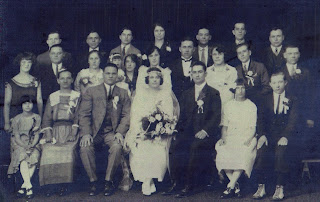It is always tough to lose a loved one, especially so close to the holidays. My grandmother Mary Ann Melnick died on December 18, 2016. We laid my grandmother to rest on December 22, 2016 next to my grandfather, Joseph.
Mary Ann was born on February 4, 1931, the youngest of five children. She was not the youngest by much, she had a twin sister, Helen. She had three older brothers, Arseny, Alexander, and John. Her father, Arseny Melnick, a native of Staraya Ushitsa, which is now present-day Ukraine, immigrated to the United States in 1916. Her mother, Rose Patek, a native of Cajla, Pezinok, Slovakia, immigrated in 1920. Her father, Arseny, died when she was only eighteen months old.
Mary Ann's mother, Rose, never remarried. All the kids helped to contribute, including Mary Ann and Helen. By age twelve, they became the first female news carriers for the
Youngstown Vindicator. Since, girls were not allowed to be newspaper carriers at that time, they worked under their older brothers name.
The family lived very frugally and Rose also sent money home to her mother in Pezinok, Slovakia. The money sent to Slovakia allowed the family there to live a bit more comfortably, buy allowing them to buy a second home which they rented out for additional income.
In 1949, Mary Ann graduated from
The Rayon School and went on to attend two years of college. During the Youngstown bus strike, she met my grandfather, Joseph. Mary Ann and her sister were dropped off at
Idora Park Ballroom. In those days, the Ballroom was the place to be; however, when they got there the place was practically empty due to the bus strike. Mary Ann turned around to leave when a Youngstown patrolman stopped her and convinced her to stay, saying you never know, you may meet your future husband here tonight. Well she stayed, Joseph asked her to dance, and they danced the night away.
On June 16, 1951, Joseph and Mary Ann married at
St. Patrick's Church in Youngstown, Ohio.
Mary Ann worked as a pharmacy technician at St. Elizabeth Hospital in Youngstown up until she was seven months pregnant with her first child. My father was born just over a year after their marriage. His younger sister was born ten years later.
Mary Ann devoted her life to her children and her family. She was an amazing cook and seamstress. She was a loving mother, aunt, great-aunt, great-great aunt, grandmother, great-grandmother, and great-great-grandmother.
Joseph, her husband of 45 years, died on June 22, 1996. She continued to live independently for another thirteen years until she moved into an assisted living facility.
I am so grateful that I had so many years to spend with my grandmother. I started researching my family history in 2010. Unfortunately, my three other grandparents died by the time I was eighteen - about 20 years ago. Long before I was interested in recording their stories.
When I heard the news, I had a good cry and a good soak in my tub. Then I decided to go through all the photos and create a photo slide show for the funeral. I was still sad but the process of scanning, editing, and labeling the photos was therapeutic for me. I saw most of the photos previously, but this time I really looked at them. I realized what a long and fulfilling life my grandmother had. Her family was her life and it showed in all of her pictures.
I am also blessed to have some audio recordings of my grandmother. I did not have the opportunity to interview my other grandparents. Much of my adult life I have lived across the country from where I grew up, which is also where my grandmother lived. Every time I came home for a visit, I would try to have a list of questions to ask her or photographs for her to identify. I made sure not to overwhelm her with questions. I also wanted to just enjoy our time together.
If you perform a Google search you will find a lot of sample questions to use to conduct oral interviews of family members. The most comprehensive list that I have found is located in the book,
Story of My Life: A Workbook for Preserving Your Legacy, by Sunny Jane Morton. I highly encourage you to interview as many relatives as you can and answer the questions yourself. Everyone has a story to tell.
I will miss you Grandma! Thank you for all the love and support you have given me through the years. I especially appreciate you being so supportive of my genealogy research and even agreeing to multiple DNA tests. I love you!
.jpg)


























